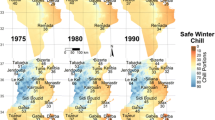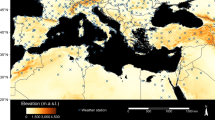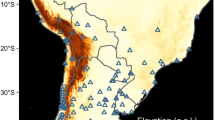Abstract
Temperate deciduous trees can only be productive where winters are cold enough to meet their chilling needs. In the Mediterranean region, chill has traditionally been sufficient for many species, but this may change as temperatures increase. We explored the region’s present and future suitability for temperate trees by quantifying chill for the Sfax region in central Tunisia, one of the warmest regions where temperate nuts are commercially grown. We assessed climatic risk by calculating historic chill (since 1973) and using a weather generator calibrated with local weather data (1973–2015) to produce 101 years of chill estimates (computed with the Dynamic Model) and 3 past and 72 future scenarios (for 2041–2070 and 2071–2100, using two representative concentration pathways: RCP4.5 and RCP8.5). For almonds and pistachios, we compared available chill during the chilling period with the species’ estimated chilling requirements, and we computed the date by which sufficient chill was expected to have accumulated. Our findings indicated severe chill losses for all future scenarios. For all species, the current chill period is no longer expected to be sufficient for meeting chilling requirements in the future. Chill needs may still be fulfilled later in the year, especially for low-chill almonds, but this would result in delayed phenology, with possible adverse effects on productivity. Temperate nut production is thus unlikely to remain viable at this site, highlighting an urgent need to identify locally appropriate adaptation options. This challenge is likely shared by other warm production regions of temperate fruits and nuts around the world.


Similar content being viewed by others
References
Abichou M, García-Mozo H, Ben Dhiab A et al (2013) Some indicators of the effect of global warming on olive tree flowering in south Tunisia. In: El-Beltagy A, Tao W, Saxena MC (eds) Global climate change and its impact on food & energy security in the drylands, Proceedings of the Eleventh International Dryland Development Conference. International Dryland Development Commission (IDDC), Beijing, pp 278–283
APIA (2016) Agence de Promotion des Investissements Agricoles. http://www.apia.com.tn/lagriculture-tunisienne-investmenu-85. Accessed 24 Nov 2016
Atkinson CJ, Brennan RM, Jones HG (2013) Declining chilling and its impact on temperate perennial crops. Environ Exp Bot 91:48–62. https://doi.org/10.1016/j.envexpbot.2013.02.004
Baldocchi D, Wong S (2008) Accumulated winter chill is decreasing in the fruit growing regions of California. Clim Chang 87:S153–S166. https://doi.org/10.1007/s10584-007-9367-8
Bebber DP, Ramotowski MAT, Gurr SJ (2013) Crop pests and pathogens move polewards in a warming world. Nat Clim Chang 3:985–988. https://doi.org/10.1038/nclimate1990
Beede RH, Ferguson L (2002) Effect of rootstock and treatment date on the response of pistachio to dormant applied horticultural mineral oil. Acta Hortic 591:53–56
Benmoussa H, Ghrab M, Ben Mimoun M, Luedeling E (2017a) Chilling and heat requirements for local and foreign almond (Prunus dulcis Mill.) cultivars in a warm Mediterranean location based on 30 years of phenology records. Agric For Meteorol 239:34–46
Benmoussa H, Luedeling E, Ghrab M, Ben Yahmed J, Ben Mimoun M (2017b) Performance of pistachio (Pistacia vera L.) in warming Mediterranean orchards. Environ Exp Bot 140:76–85
Campoy JA, Ruiz D, Cook N, Allderman L, Egea J (2011a) High temperatures and time to budbreak in low chill apricot “Palsteyn”. Towards a better understanding of chill and heat requirements fulfillment. Sci Hortic (Amsterdam) 129:649–655. https://doi.org/10.1016/j.scienta.2011.05.008
Campoy JA, Ruiz D, Egea J (2011b) Dormancy in temperate fruit trees in a global warming context: a review. Sci Hortic (Amsterdam) 130:357–372. https://doi.org/10.1016/j.scienta.2011.07.011
Campoy JA, Ruiz D, Allderman L, Cook N, Egea J (2012) The fulfilment of chilling requirements and the adaptation of apricot (Prunus armeniaca L.) in warm winter climates: an approach in Murcia (Spain) and the Western Cape (South Africa). Eur J Agron 37:43–55. https://doi.org/10.1016/j.eja.2011.10.004
Cordano AE, Eccel E (2014) Package “ RMAWGEN ” - Weather Generator R Package Version 13.0 http://cran.r-project.org/web/packages/RMAWGEN/index.html
Cordano E, Eccel E (2016) Tools for stochastic weather series generation in R environment. Ital J Agrometeorol 21:31–42. https://doi.org/10.19199/2016.3.2038-5625.031
Darbyshire R, Webb L, Goodwin I, Barlow S (2011) Winter chilling trends for deciduous fruit trees in Australia. Agric For Meteorol 151:1074–1085. https://doi.org/10.1016/j.agrformet.2011.03.010
Darbyshire R, Webb L, Goodwin I, Barlow EWR (2013) Impact of future warming on winter chilling in Australia. Int J Biometeorol 57:355–366. https://doi.org/10.1007/s00484-012-0558-2
De Melo-Abreu JP, Barranco D, Cordeiro AM et al (2004) Modelling olive flowering date using chilling for dormancy release and thermal time. Agric For Meteorol 125:117–127. https://doi.org/10.1016/j.agrformet.2004.02.009
DGPA (2015) Agricultural statistics. Tunisia
Elloumi O, Ghrab M, Kessentini H, Ben Mimoun M (2013) Chilling accumulation effects on performance of pistachio trees cv. Mateur in dry and warm area climate. Sci Hortic (Amsterdam) 159:80–87. https://doi.org/10.1016/j.scienta.2013.05.004
Erez A (1987) Chemical control of budbreak. HortScience 22:1240–1243
Erez A (1995) Means to compensate for insufficient chilling to improve bloom and leafing. Acta Hortic 395:81–95
Faust M, Erez A, Rowland LJ et al (1997) Bud dormancy in perennial fruit trees: physiological basis for dormancy induction, maintenance, and release. HortScience 32:623–629
Fishman S, Erez A, Couvillon GA (1987a) The temperature dependence of dormancy breaking in plants: computer simulation of processes studied under controlled temperatures. J Theor Biol 126:309–321. https://doi.org/10.1016/S0022-5193(87)80237-0
Fishman S, Erez A, Couvillon GA (1987b) The temperature dependence of dormancy breaking in plants: mathematical analysis of a two-step model involving a cooperative transition. J Theor Biol 124:473–483. https://doi.org/10.1016/S0022-5193(87)80221-7
Funes I, Aranda X, Biel C, Carbó J, Camps F, Molina AJ, Herralde F, Grau B, Savé R (2016) Future climate change impacts on apple flowering date in a Mediterranean subbasin. Agric Water Manag 164:19–27. https://doi.org/10.1016/j.agwat.2015.06.013
Gabaldón-Leal C, Ruiz-Ramos M, de la Rosa R et al (2017) Impact of changes in mean and extreme temperatures caused by climate change on olive flowering in southern Spain. Int J Climatol 37:940–957. https://doi.org/10.1002/joc.5048
Gebauer J, Luedeling E, Hammer K et al (2009) Agrobiodiversity in mountain oases of northern Oman. Acta Hortic 817:325–332
General Directorate for Agricultural Studies and Development (2017) Agricultural statistics yearbook 2015 (in Arabic), Ministry of Agriculture, Water Resources and Fisheries, Tunis
George AP, Nissen RJ (1988) Chemical methods on breaking dormancy of low chill nectarines : preliminary evaluations in subtropical Queensland. Aust J Exp Agric 28:425–429
George AP, Lloyd J, Nissen RJ (1992) Effects of hydrogen cyanamide, paclobutrazol and pruning date on dormancy release of the low chill peach cultivar flordaprince in subtropical Australia. Aust J Exp Agric 32:89–95. https://doi.org/10.1071/EA9920089
Ghrab M, Ben Mimoun M (2013) Effective hydrogen cyanamide (Dormex®) application for bud break, flowering and nut yield of pistachio trees cv. Mateur in warm growing areas. Exp Agric 50:398–406. https://doi.org/10.1017/S0014479713000550
Ghrab M, Ben Mimoun M, Masmoudi MM, Ben Mechlia N (2014a) Chilling trends in a warm production area and their impact on flowering and fruiting of peach trees. Sci Hortic (Amsterdam) 178:87–94. https://doi.org/10.1016/j.scienta.2014.08.008
Ghrab M, Ben Mimoun M, Masmoudi MM, Ben Mechlia N (2014b) The behaviour of peach cultivars under warm climatic conditions in the Mediterranean area. Int J Environ Stud 71:3–14. https://doi.org/10.1080/00207233.2013.862945
Ghrab M, Ben Mimoun M, Masmoudi MM, Ben Mechlia N (2016) Climate change and vulnerability of the pistachio and almond crops in the Mediterranean arid areas. Options Méditerranéennes, A XVI GREMPA Meeting on Almonds and Pistachio 119:247–251
Hijmans RJ, Cameron SE, Parra JL, Jones PG, Jarvis A (2005) Very high resolution interpolated climate surfaces for global land areas. Int J Climatol 25:1965–1978. https://doi.org/10.1002/joc.1276
Jones HG, Hillis RM, Gordon SL, Brennan RM (2013) An approach to the determination of winter chill requirements for different Ribes cultivars. Plant Biol 15:18–27. https://doi.org/10.1111/j.1438-8677.2012.00590.x
Küden AB, Küden A, Nikpeyma Y, Kaska N (1995) Effects of chimicals on bud break of pistachios under mild climate conditions. Acta Hortic 419:91–96
Luedeling E (2012) Climate change impacts on winter chill for temperate fruit and nut production: a review. Sci Hortic (Amsterdam) 144:218–229. https://doi.org/10.1016/j.scienta.2012.07.011
Luedeling E (2018a) Interpolating hourly temperatures for computing agroclimatic metrics. Int J Biometeorol 62:1799–1807. https://doi.org/10.1007/s00484-018-1582-7
Luedeling E (2018b) chillR – Statistical methods for phenology analysis in temperate fruit trees. R Package Version 0.70. http://cran.r-project.org/web/packages/chillR
Luedeling E, Brown PH (2011) A global analysis of the comparability of winter chill models for fruit and nut trees. Int J Biometeorol 55:411–421. https://doi.org/10.1007/s00484-010-0352-y
Luedeling E, Gebauer J, Buerkert A (2009a) Climate change effects on winter chill for tree crops with chilling requirements on the Arabian Peninsula. Clim Chang 96:219–237. https://doi.org/10.1007/s10584-009-9581-7
Luedeling E, Zhang M, Girvetz EH (2009b) Climatic changes lead to declining winter chill for fruit and nut trees in California during 1950-2099. PLoS One 4:e6166. https://doi.org/10.1371/journal.pone.0006166
Luedeling E, Zhang M, Luedeling V, Girvetz EH (2009c) Sensitivity of winter chill models for fruit and nut trees to climatic changes expected in California’s Central Valley. Agric Ecosyst Environ 133:23–31. https://doi.org/10.1016/j.agee.2009.04.016
Luedeling E, Zhang M, McGranahan G, Leslie C (2009d) Validation of winter chill models using historic records of walnut phenology. Agric For Meteorol 149:1854–1864. https://doi.org/10.1016/j.agrformet.2009.06.013
Luedeling E, Girvetz EH, Semenov MA, Brown PH (2011a) Climate change affects winter chill for temperate fruit and nut trees. PLoS One 6:e20155. https://doi.org/10.1371/journal.pone.0020155
Luedeling E, Steinmann KP, Zhang M et al (2011b) Climate change effects on walnut pests in California. Glob Chang Biol 17:228–238. https://doi.org/10.1111/j.1365-2486.2010.02227.x
McLeod AI (2011) “Kendall”. Contributed package for the R programming language. 12
Ministère de l’Agriculture des Ressources Hydrauliques et de la Pêche (2015) La Tunisie à la COP21- Paris, du 30 Novembre au 11 Décembre 2015. Paris, France
Orlandi F, Vazquez LM, Ruga L et al (2005) Bioclimatic requirements for olive flowering in two Mediterranean regions located at the same latitude (Andalucia, Spain and Sicily, Italy). Ann Agric Environ Med 12:47–52
Park Y, Lee B, Park H (2018) Predicted effects of climate change on winter chill accumulation by temperate trees in South Korea. Hortic J Preview 87:166–173. https://doi.org/10.2503/hortj.OKD-089
Pérez FJ, Ormeño JT, Reynaert B, Rubio S (2008) Use of the dynamic model for the assessment of winter chilling in a temperate and a subtropical climatic zone of Chile. Chil J Agric Res 68:198–206
Platts PJ, Omeny PA, Marchant R (2015) AFRICLIM: high-resolution climate projections for ecological applications in Africa. Afr J Ecol 53:103–108. https://doi.org/10.1111/aje.12180
Preston JC, Sandve SR (2013) Adaptation to seasonality and the winter freeze. Front Plant Sci 4:1–18. https://doi.org/10.3389/fpls.2013.00167
Rahemi M, Asghari H (2004) Effect of hydrogen cyanamide (dormex), volk oil and potassium nitrate on budbreak, yield and nut characteristics of pistachio (Pistacia vera L.). J Hortic Sci Biotechnol 79:823–827. https://doi.org/10.1080/14620316.2004.11511849
Rallo L, Martin GC (1991) The role of chilling in releasing olive floral buds from dormancy. J Am Soc Hortic Sci 116:1058–1062
Reddy PP (2006) Impact of climate change on insect pests of trees. Pest Manag Hortic Ecosyst 19:225–233
Ruiz D, Campoy JA, Egea J (2007) Chilling and heat requirements of apricot cultivars for flowering. Environ Exp Bot 61:254–263. https://doi.org/10.1016/j.envexpbot.2007.06.008
Sánchez-Pérez R, Ortega E, Duval H, Martínez-Gómez P, Dicenta F (2007) Inheritance of several important agronomic traits in almond. Euphytica 155:381–391. https://doi.org/10.1007/s10681-006-9339-5
Saure MC (1985) Dormancy release in deciduous fruit trees. In: Janick J (ed) Horticultural reviews, Volume 7, The AVI Publishing Company, Inc. , St. Petersburg, pp 239–300
Savé R, de Herralde F, Aranda X, Pla E, Pascual D, Funes I, Biel C (2012) Potential changes in irrigation requirements and phenology of maize, apple trees and alfalfa under global change conditions in Fluvià watershed during XXIst century: results from a modeling approximation to watershed-level water balance. Agric Water Manag 114:78–87. https://doi.org/10.1016/j.agwat.2012.07.006
Schep L, Temple W, Beasley M (2009) The adverse effects of hydrogen cyanamide on human health: an evaluation of inquiries to the New Zealand National Poisons Centre. Clin Toxicol 47:58–60. https://doi.org/10.1080/15563650802459254
Semenov MA (2008) Simulation of extreme weather events by a stochastic weather generator. Clim Res 35:203–212. https://doi.org/10.3354/cr00731
Sheshadri SH, Sudhir U, Kumar S, Kempegowda P (2011) DORMEX®-hydrogen cyanamide poisoning. J Emerg Trauma Shock 4:435–437
Vegis A (1964) Dormancy in higher plants. Annu Rev Plant Physiol 15:185–224
Zhang J, Taylor C (2011) The Dynamic Model provides the best description of the chill process on “Sirora” pistachio trees in Australia. HortScience 46:420–425
Acknowledgements
We are grateful to the technical staff of Institut de l’Olivier (Khecharem A. and Njah A.) in Sfax, Tunisia, for supporting the field survey and providing data.
Funding
We thank the Tunisian Ministry of Higher Education and Scientific Research for providing a scholarship for doctoral training to carry out this study. We also appreciate support from the German Ministry of Education and Research (BMBF) for supporting this work through the “Phenological And Social Impacts of Temperature increase—climatic consequences for fruit production in Tunisia, Chile and Germany” (PASIT) project (grant no. 031B0467B).
Author information
Authors and Affiliations
Corresponding author
Electronic supplementary material
Supplementary Table S1
(PDF 324 kb)
Rights and permissions
About this article
Cite this article
Benmoussa, H., Ben Mimoun, M., Ghrab, M. et al. Climate change threatens central Tunisian nut orchards. Int J Biometeorol 62, 2245–2255 (2018). https://doi.org/10.1007/s00484-018-1628-x
Received:
Revised:
Accepted:
Published:
Issue Date:
DOI: https://doi.org/10.1007/s00484-018-1628-x




